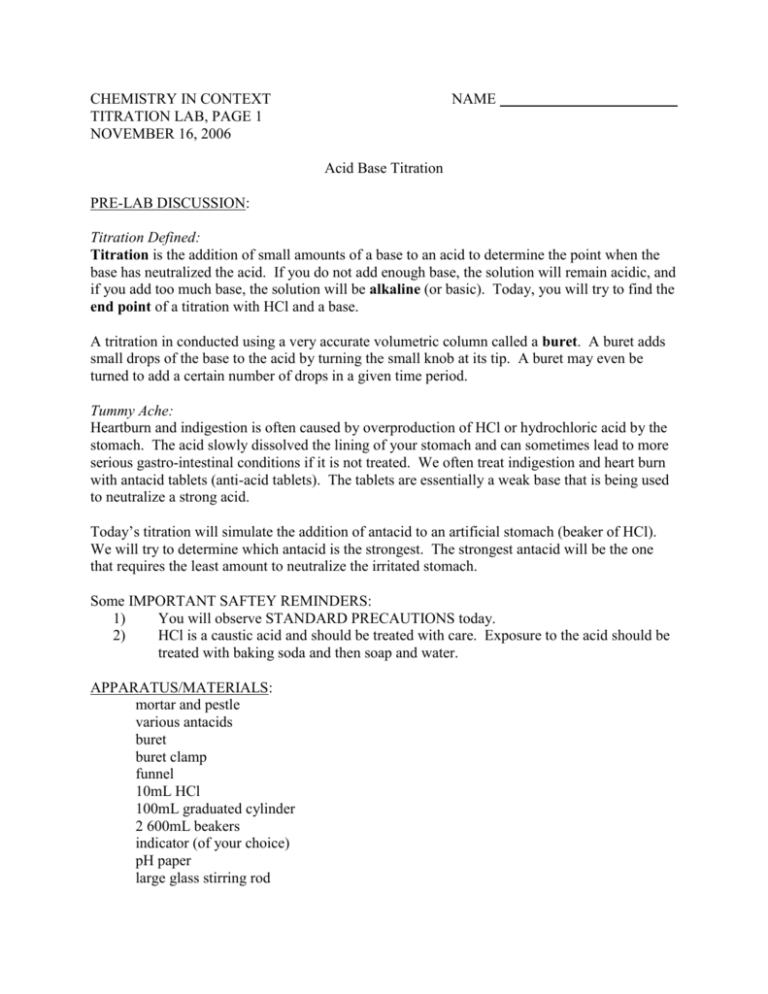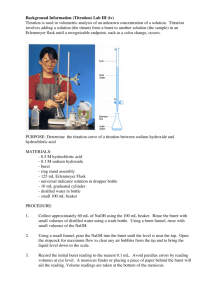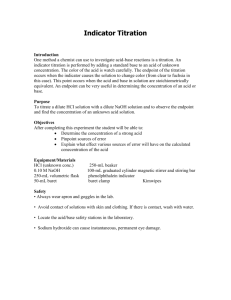Acid-Base Titration - The Lexington School
advertisement

CHEMISTRY IN CONTEXT TITRATION LAB, PAGE 1 NOVEMBER 16, 2006 NAME Acid Base Titration PRE-LAB DISCUSSION: Titration Defined: Titration is the addition of small amounts of a base to an acid to determine the point when the base has neutralized the acid. If you do not add enough base, the solution will remain acidic, and if you add too much base, the solution will be alkaline (or basic). Today, you will try to find the end point of a titration with HCl and a base. A tritration in conducted using a very accurate volumetric column called a buret. A buret adds small drops of the base to the acid by turning the small knob at its tip. A buret may even be turned to add a certain number of drops in a given time period. Tummy Ache: Heartburn and indigestion is often caused by overproduction of HCl or hydrochloric acid by the stomach. The acid slowly dissolved the lining of your stomach and can sometimes lead to more serious gastro-intestinal conditions if it is not treated. We often treat indigestion and heart burn with antacid tablets (anti-acid tablets). The tablets are essentially a weak base that is being used to neutralize a strong acid. Today’s titration will simulate the addition of antacid to an artificial stomach (beaker of HCl). We will try to determine which antacid is the strongest. The strongest antacid will be the one that requires the least amount to neutralize the irritated stomach. Some IMPORTANT SAFTEY REMINDERS: 1) You will observe STANDARD PRECAUTIONS today. 2) HCl is a caustic acid and should be treated with care. Exposure to the acid should be treated with baking soda and then soap and water. APPARATUS/MATERIALS: mortar and pestle various antacids buret buret clamp funnel 10mL HCl 100mL graduated cylinder 2 600mL beakers indicator (of your choice) pH paper large glass stirring rod CHEMISTRY IN CONTEXT TITRATION LAB, PAGE 2 NOVEMBER 16, 2006 NAME PROCEDURE: 1) Place the buret in the buret clamp so that a large beaker could fit underneath it. 2) Use the graduated cylinder to measure 25mL of HCl into a 600mL beaker. Then, RINSE the graduated cylinder out. 3) Add 40 drops of your choice of indicator to the beaker with the acid. Swirl the beaker, and place it underneath the buret. 4) Select one of the following antacids: a) Mylanta b) Maalox c) Tums d) Rolaids 5) If you select one of the first two in the list, following steps #6-13. If you select one of the last two on the list, follow steps #14-21. 6) Use the graduated cylinder to measure 10mL of antacid into an empty 600mL beaker. Then, use HOT tap water to dilute the antacid to 300mL. 7) Place a funnel into the top of your buret. Make sure that the stopcock on the buret is turned perpendicular to the buret so that’s its NOT OPEN. 8) Carefully and SLOWLY (to prevent overflow) fill your buret to the highest mark on the top. 9) Dip one small piece of pH paper into the acid beaker and compare the color it changes to the sides of the pH paper container to determine the pH of your solution. Record this number ALONG WITH the color that the indicator appears in the acid beaker. 10) Turn your stopcock on your buret and begin adding antacid solution to your acid beaker. EVERY 25mL, check the pH of the acid beaker using a small strip of pH paper AND record the color of the indicator in the beaker. 11) After your buret empties, check the pH of the acid beaker using a small strip of pH paper AND record the color of the indicator in the beaker. REFILL your buret with antacid solution and repeat step 10. 12) Continue steps #10-11 until your have emptied your antacid beaker. 13) Clean up all materials by disposing them down the sink. Use the EXTRA LONG test tube brush to clean out your burets. 14) Acquire TWO antacids tablets and use your mortar and pestle to grind them up to a FINE powder. Add the powder to an empty 600mL beaker. Dilute the tablets with HOT water up to 300mL. Use your stirring rod. 15) Place a funnel into the top of your buret. Make sure that the stopcock on the buret is turned perpendicular to the buret so that’s its NOT OPEN. 16) Carefully and SLOWLY (to prevent overflow) fill your buret to the highest mark on the top. CHEMISTRY IN CONTEXT TITRATION LAB, PAGE 3 NOVEMBER 16, 2006 17) 18) 19) 20) 21) NAME Dip one small piece of pH paper into the acid beaker and compare the color it changes to the sides of the pH paper container to determine the pH of your solution. Record this number ALONG WITH the color that the indicator appears in the acid beaker. Turn your stopcock on your buret and begin adding antacid solution to your acid beaker. EVERY 25mL, check the pH of the acid beaker using a small strip of pH paper AND record the color of the indicator in the beaker. After your buret empties, check the pH of the acid beaker using a small strip of pH paper AND record the color of the indicator in the beaker. REFILL your buret with antacid solution and repeat step 10. Continue steps #10-11 until your have emptied your antacid beaker. Clean up all materials by disposing them down the sink. Use the EXTRA LONG test tube brush to clean out your burets. DATA/OBSERVATIONS: Volume Titrated (mL) 25 50 75 100 125 150 175 200 225 250 275 300 pH (paper) Indicator Color (beaker) CHEMISTRY IN CONTEXT TITRATION LAB, PAGE 2 NOVEMBER 16, 2006 NAME ANALYSIS: 1) Which indicator did you use? Use the Internet OR your old lab to determine the colors that it will turn in the presence of the following: a) strong acid b) weak acid c) neutral d) weak base e) strong base 2) Use a piece of graph paper to graph the pH of your solution as a function of titrated volume. So, pH is on the Y axis and titrated volume is on the X axis. Use the attached graph paper….







